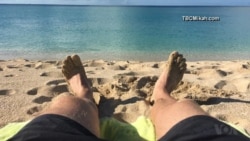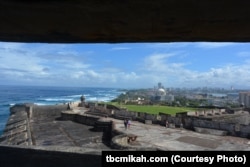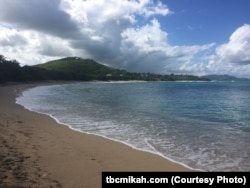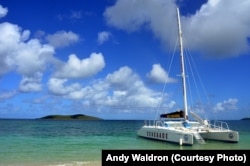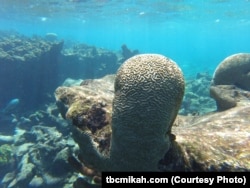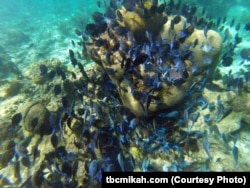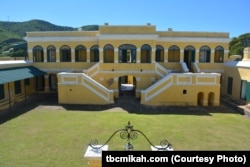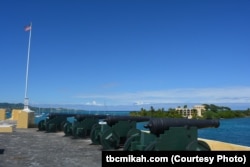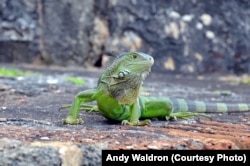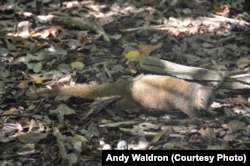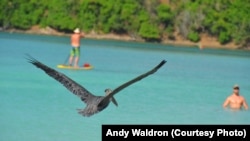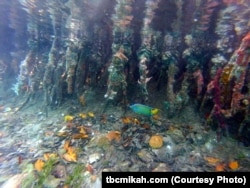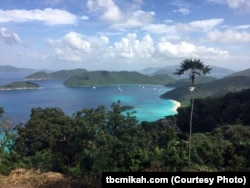It may surprise some people to learn that in addition to its 50 states and Washington, D.C., the United States includes more than a dozen territories located in the Pacific Ocean and Caribbean Sea. The Caribbean territories include Puerto Rico and the U.S. Virgin Islands.
That’s where national parks traveler Mikah Meyer recently traveled to visit six pristine National Park Service sites.
A centuries-old complex
His first stop was the capital city of Puerto Rico, where he stepped into 500 years of history at the San Juan National Historic Site, a massive fort which was used to control the island.
Puerto Rico was a Spanish colony for centuries but was turned over to the United States following the Spanish-American war of 1898. Today, visitors come to this World Heritage Site to learn about its history and unique architecture.
“I was just blown away by the size of it all,” Mikah said, “I mean some of the forts I've gone to thus far are maybe a city block in size or smaller, and this was three separate sites that were probably four or five city blocks combined.”
He noted how different it looked, compared to other forts he'd visited, from the American Revolution or the War of 1812. “It was in such a completely different climate and had such a different ambiance to it than any of these other ones that I'd been to.”
Caribbean gem
Mikah had another chance for great views of the stunning land and seascapes of Puerto Rico on his flight over to the island of St. Croix -- the largest of the three U.S. Virgin Islands, but the least crowded.
Mikah said it was fascinating to be in a beautiful place that was so “non-touristy.” He and his travel companion Andy Waldron felt like locals as they rented a car and drove to practically every part of the island, where they discovered the residents had “a really laid-back attitude.”
Just off St. Croix is the Buck Island Reef National Monument, known for its nesting sites for turtles and birds, and its “underwater trail.”
The small, uninhabited island and its surrounding reef were designated a national monument by President John F. Kennedy in 1961. “Basically he had gone there on vacation with his family, snorkeled this Buck Island Reef, thought it was amazing and decided to save it as a National Monument,” Mikah explained.
President Bill Clinton expanded the monument in 2001, declaring it the first marine protected area in the National Park Service.
While hurricanes and rising sea temperatures have damaged and continue to threaten the fragile coral, many fish populations and a large number of native plant and animal species like the brown pelican and the St. Croix ground lizard are thriving in these protected spaces.
Finding Nemo
Despite his fear of the water, and inspired by what he might find in the clear blue sea, Mikah learned how to snorkel on the spot and dived in. He followed the markers of the “underground trail” where he explored the ancient barrier reef that wraps around two thirds of the island.
“They gave us an hour to snorkel around and it was kind of like being an explorer,” he said. “You'd be snorkeling and there would be this amazing brain coral that looks like a giant brain the size of a baby elephant… and then you might come around the coral and see this amazing fish -- and it was like Finding Nemo in real life,” he said, referring to the hugely popular 2003 film of the same name.
But the most amazing moment of all, he related, was the giant school of fish that he encountered. “I think it was 300 fish just came passing by,” he said. “So I was basically swimming with this school of fish.”
“For someone who grew up in Nebraska, not near the ocean, it was just the complete opposite of what I was used to and it was so fascinating,” Mikah said. “It's definitely my new favorite national monument."
Christian’s Place
After Buck Island, Mikah headed to the Christiansted National Historic Site, which is home to a colorful old Danish fort.
“Their colors for their military sites were yellow and green… so it was this glorious yellow with these gorgeous green shutters.”
The urban park features 18th and 19th century structures in the heart of Christiansted, the capital of the former Danish West Indies on St. Croix Island. Christiansted, which means Christian’s Place, was named in honor of King Christian VI of Denmark and Norway, and was envisioned as a rival to Christiania (later Olso), Norway, in size. According to the National Park Service, it exemplifies the architectural, economic and political influence of Europe like no other place in the Caribbean.
Mikah was particularly impressed by the history behind the strategic placement of the cannons around the fort.
“The tour guide, Bonito Vegas, talked to us about how you could see in the distance where the coral was, and so they knew boats wouldn’t come in that way, so they didn't have to put cannons there,” he recounted. “But they knew this one section had deep water… so if the boats wanted to come, this is where their cannons had to be.”
2,000 years of human history
The next stop for Mikah was the Salt River Bay National Historical Park and Ecological Preserve on St. Croix Island.
“That site is a historical point but it's also an ecological preserve because they found that within this bay there's a bunch of marine life that universities from all over the country come to study and so the National Park Service has been able to preserve that.”
The site is also famous for its first European visitor -- Christopher Columbus. “He stopped here on his second visit to the Caribbean where he came in search of fresh water,” Mikah said.
Caribbean wildlife
Mikah was impressed by the diversity of the wildlife on the islands. “Each place we went, even though they were so close, all had their own what I call ‘national park zoo,’” he said.
“So in the San Juan National Historic Site there was this massive green iguana,” he described,” a color that you couldn't imagine was real or came from nature.” And then there were the hermit crabs. “They were everywhere,” Mikah said. “If it wasn't developed, it was covered in hermit crabs…and I was scared of stepping on one,” he recounted with a laugh.
And on St. Croix, there were mongooses.
“Apparently the Europeans brought them over to eat the rats," Mikah said. But apparently they weren't too keen on rats, "so they ended up eating a bunch of the other species on the islands, which are now extinct,” Mikah pointed out.
But what really took his breath away, Mikah said, was the Caribbean marine life. Observing them in their habitat and exploring other underwater treasures was a transforming experience for him.
Look, but don’t touch!
While snorkeling in Maho Bay on St. John Island, he saw sting rays and sea turtles. “You wouldn't imagine this turtle that kind of plops around on sand being graceful but they are in the water,” he said. “They were made to swim.”
And at the Virgin Islands Coral Reef National Monument, he explored little coves and mangrove forests that help build a sustainable ecology.
“There are these trees that grow out into the ocean and actually help build new ground around the earth because they put their roots out into the ocean and then bits of debris and sand get caught on the roots and eventually those collect and become earth,” he described. “So they basically build habitats on level ground so they also serve as nesting areas for baby fish.”
Around the mangrove roots Mikah saw vibrant queen angelfish, which he described as a stunning visual scene. “They are blue fish that have these magnetic yellow stripes down them,” he explained. “It looks like somebody painted them with glow paint.”
“It was an honor for me to get to experience these places… I just felt so lucky because this was something that a little kid from the prairie in Nebraska wouldn’t have imagined himself doing. And yet here I was in my own country, seeing a landscape that was so foreign, and yet was part of my story and my nation’s story and will still be for years hopefully, if we keep protecting it.”
To learn more about his time in the Caribbean and the many other sites he visited, Mikah invites you to visit him on his website, Facebook and Instagram.




